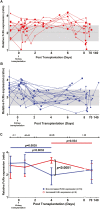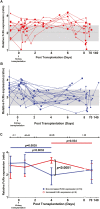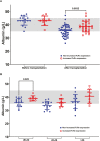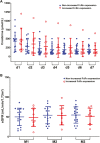Albumin influences leucocyte FcRn expression in the early days of kidney transplantation
- PMID: 38353127
- PMCID: PMC11097912
- DOI: 10.1093/cei/uxae011
Albumin influences leucocyte FcRn expression in the early days of kidney transplantation
Abstract
FcRn, a receptor originally known for its involvement in IgG and albumin transcytosis and recycling, is also important in the establishment of the innate and adaptive immune response. Dysregulation of the immune response has been associated with variations in FcRn expression, as observed in cancer. Recently, a link between autophagy and FcRn expression has been demonstrated. Knowing that autophagy is strongly involved in the development of reperfusion injury in kidney transplantation and that albuminemia is transiently decreased in the first 2 weeks after transplantation, we investigated variations in FcRn expression after kidney transplantation. We monitored FcRn levels by flow cytometry in leukocytes from 25 renal transplant patients and considered parameters such as albumin concentrations, estimated glomerular filtration rate, serum creatinine, serum IgG levels, and ischaemia/reperfusion time. Two groups of patients could be distinguished according to their increased or non-increased FcRn expression levels between days 2 and 6 (d2-d6) post-transplantation. Leukocyte FcRn expression at d2-d6 was correlated with albumin concentrations at d0-d2. These results suggest that albumin concentrations at d0-d2 influence FcRn expression at d2-d6, raising new questions about the mechanisms underlying these original observations.
Keywords: FcRn; albumin; flow cytometry; kidney transplantation.
© The Author(s) 2024. Published by Oxford University Press on behalf of the British Society for Immunology.
Conflict of interest statement
None declared.
Figures








Similar articles
-
Renal FcRn reclaims albumin but facilitates elimination of IgG.J Am Soc Nephrol. 2009 Sep;20(9):1941-52. doi: 10.1681/ASN.2008090976. Epub 2009 Aug 6. J Am Soc Nephrol. 2009. PMID: 19661163 Free PMC article.
-
Autophagy gene ATG7 regulates albumin transcytosis in renal tubule epithelial cells.Am J Physiol Renal Physiol. 2021 Nov 1;321(5):F572-F586. doi: 10.1152/ajprenal.00172.2021. Epub 2021 Sep 20. Am J Physiol Renal Physiol. 2021. PMID: 34541900
-
Differential trafficking of albumin and IgG facilitated by the neonatal Fc receptor in podocytes in vitro and in vivo.PLoS One. 2019 Feb 27;14(2):e0209732. doi: 10.1371/journal.pone.0209732. eCollection 2019. PLoS One. 2019. PMID: 30811433 Free PMC article.
-
The immunologic functions of the neonatal Fc receptor for IgG.J Clin Immunol. 2013 Jan;33 Suppl 1(Suppl 1):S9-17. doi: 10.1007/s10875-012-9768-y. Epub 2012 Sep 5. J Clin Immunol. 2013. PMID: 22948741 Free PMC article. Review.
-
The Neonatal Fc Receptor (FcRn): A Misnomer?Front Immunol. 2019 Jul 10;10:1540. doi: 10.3389/fimmu.2019.01540. eCollection 2019. Front Immunol. 2019. PMID: 31354709 Free PMC article. Review.
References
-
- Brambell FWR. The transmission of immune globulins from the mother to the foetal and newborn young. Proc Nutr Soc 1969, 28, 35–41. doi:10.1079/PNS19690007 - DOI - PubMed
MeSH terms
Substances
Grants and funding
LinkOut - more resources
Full Text Sources
Medical

